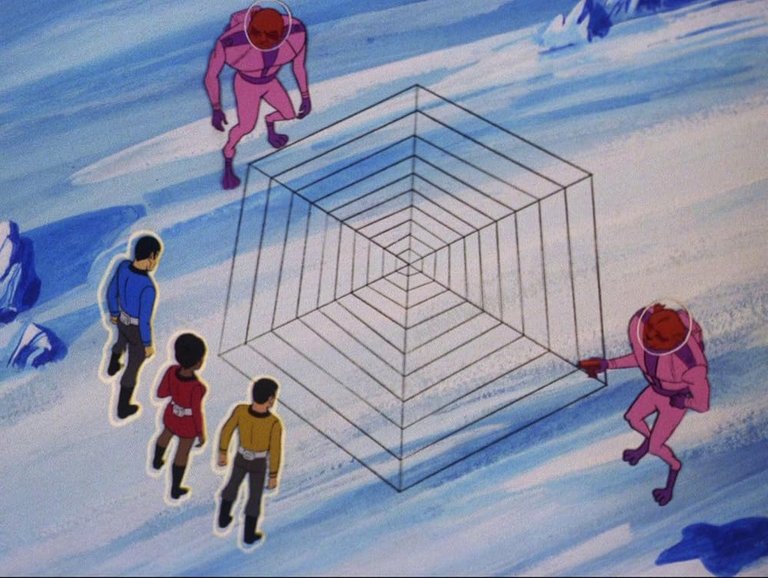Television Review: The Slaver Weapon (Star Trek: The Animated Series, S1X14, 1973)

The Slaver Weapon (S01E14)
Airdate: December 15th 1973
Written by: Larry Niven
Directed by: Hal Sutherland
Running Time: 22 minutes
One of the peculiarities of Star Trek’s long and distinguished history is its almost complete lack of canonical crossovers with other fictional universes across film, television, or official media. While the franchise has occasionally referenced or loosely adapted elements from external science fiction lore, such interactions have remained rare and non-binding within its own continuity. The sole exception, occurring relatively early in the franchise’s evolution, is The Slaver Weapon, an episode of Star Trek: The Animated Series (1973). This episode stands out not only as a rare instance of inter-universal collaboration but also as a bold creative experiment that bridges two seminal worlds: Gene Roddenberry’s Star Trek and Larry Niven’s Known Space saga. Its uniqueness lies in its status as the only officially sanctioned crossover between Star Trek and another established sci-fi universe, a distinction that remains unchallenged even decades later.
The Slaver Weapon was written by Larry Niven, a renowned science fiction author whose work had already intersected with Star Trek during its formative years. Niven, best known for his Hugo and Nebula Award-winning novel Ringworld (1970), was part of a cohort of prominent writers whose involvement lent intellectual heft to the franchise in its formative years. Niven’s contribution stemmed from his Known Space universe, a sprawling cosmos first introduced in his 1966 story Neutron Star, but more directly tied to the 1967 short story The Soft Weapon. Gene Roddenberry, seeking to infuse the series with fresh ideas, proposed adapting The Soft Weapon into an episode by recontextualising its plot and characters within the Star Trek framework. This adaptation followed an earlier precedent set by The Original Series episode Arena (1966), which transposed Fredric Brown’s 1944 short story of the same name into a Starfleet-versus-alien battle. Niven’s involvement, however, marked a more ambitious fusion of two established universes, albeit with significant narrative compromises to align with Star Trek’s tone and parameters.
The episode follows the USS Enterprise’s shuttlecraft Copernicus, tasked with transporting a Slaver stasis box—a relic from the eponymous ancient, galaxy-dominating race—to Starbase 25. The crew includes Spock, Sulu, and Uhura, who divert course after detecting a signal from another Slaver artefact. This leads them to an ice planet in the Beta Lyrae system, where they discover a second stasis box. Unbeknownst to them, the signal is a trap orchestrated by the Kzinti, a feline warrior race intent on acquiring Slaver technology. After the crew is captured, Spock and Sulu escape, retrieve the box, and uncover its contents: a weapon of immense power, capable of unimaginable destruction. However, the weapon’s AI—a remnant of the Slavers—activates a self-destruct sequence upon detecting unauthorised use. In a tense climax, the Kzinti are obliterated, and the trio narrowly escapes. Spock reflects that the weapon’s destruction was fortuitous, underscoring the episode’s theme of forbidden knowledge and the dangers of unchecked technological power.
The episode’s canonical status remains contentious among both Star Trek and Known Space devotees. The primary issue lies in the conflicting timelines and lore of the two universes. Niven’s Known Space predates Star Trek’s 23rd-century setting, with the Slavers existing billions of years prior to the Enterprise’s era. Additionally, the portrayal of the Kzinti diverges significantly from Niven’s original vision: the animated version depicts them as stripeless, less intellectually formidable, and far less menacing than their literary counterparts. These changes, likely driven by budget constraints and the animated format’s limitations, dilute the race’s inherent complexity. For Star Trek purists, the episode’s embrace of a non-canon universe further complicates its place within the franchise’s mythos. Despite these flaws, the episode’s audacity in attempting such a crossover—and its influence on later adaptations—cannot be understated.
Despite its canonical and stylistic compromises, The Slaver Weapon succeeds as a concise, engaging narrative. Niven’s adaptation skillfully condenses the dense, philosophical ideas of The Soft Weapon—such as the ethics of alien technology and the hubris of civilisations—into 22 minutes of runtime. The episode balances exposition with action, explaining Slaver history and Kzinti motives without sacrificing momentum. The pacing is brisk, the stakes palpable, and the AI’s self-destruct mechanism provides a morally ambiguous climax that challenges the protagonists’ assumptions.
A notable footnote in Star Trek history is the episode’s absence of Captain James T. Kirk. This marks the first time a main Star Trek episode does not feature the iconic captain, something that won't occure until the pilot of Star Trek: The Next Generation in 1987. The episode’s focus on Spock, Sulu, and Uhura allows for character-driven dynamics that differ from Kirk’s leadership-centric narratives, offering a glimpse of Trek’s potential for ensemble storytelling. This experiment, while minor, subtly hints at the franchise’s evolving direction.
Despite its mixed reception at the time—dismissed by some as an oddity or a pale imitation of Niven’s work—The Slaver Weapon has since accrued a devoted following. Its most significant posthumous validation came in the 21st century, when Star Trek: Picard (2020) and Star Trek: Lower Decks (2020) formally integrated the Kzinti into the Star Trek canon, cementing their legacy. These nods acknowledge the episode’s role in introducing one of science fiction’s most compelling alien races to the franchise. For fans, The Slaver Weapon remains a curiosity—a bold, imperfect bridge between universes that, for all its flaws, embodies the spirit of intergalactic storytelling that defines both Star Trek and Niven’s Known Space.
RATING: 7/10 (+++)
Blog in Croatian https://draxblog.com
Blog in English https://draxreview.wordpress.com/
InLeo blog https://inleo.io/@drax.leo
InLeo: https://inleo.io/signup?referral=drax.leo
Leodex: https://leodex.io/?ref=drax
Hiveonboard: https://hiveonboard.com?ref=drax
Rising Star game: https://www.risingstargame.com?referrer=drax
1Inch: https://1inch.exchange/#/r/0x83823d8CCB74F828148258BB4457642124b1328e
BTC donations: 1EWxiMiP6iiG9rger3NuUSd6HByaxQWafG
ETH donations: 0xB305F144323b99e6f8b1d66f5D7DE78B498C32A7
BCH donations: qpvxw0jax79lhmvlgcldkzpqanf03r9cjv8y6gtmk9